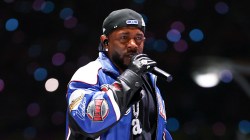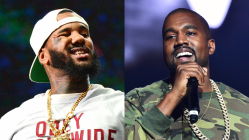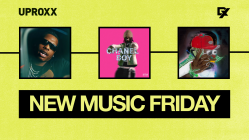“I could pack a house in any city on the earth / It don’t matter if you feel me or hear me on your way to work…” –A-Plus, “The One.”
Recently I’ve had the pleasure of being part of the crowd during an Arrested Development show in Sarajevo, Bosnia-Herzegovina—a city in Southeast Europe gripping to re-establish itself 16 years after heavy aggression. When touring, most artists skip the proud host of ‘84 Winter Olympics, as direct flights to Sarajevo are as common as tape decks. Nonetheless, it was pleasant to be part of the cocktail crowd of Hip Hop fans, international workers, and regular partygoers, all of whom filled the dark, spacious underground club.
Before moving to Sarajevo, my last crowd experience was at shows of heavy-hitters including De La Soul, Rakim, Drake (Fabolous, Jay-Z, Eminem, Kardinal Offishall, Bun B, and others all made surprise appearances, kind of like those Russian matryoshka dolls). Toronto’s crowds were each as live as the previous, as was Sarajevo’s troop that night. Despite high energy, there was a difference in Balkan energy, the same difference I felt when Parisian rappers and deejays stepped on stage—or any given backyard party. So what was it?
To discuss the difference in crowds, on a global level, I enlisted Talib Kweli, Immortal Technique, Ras Kass, and Elzhi—rappers well familiar with pleasing crowds in the US and overseas. Speech, lead singer of AD, who bore witness to Sarajevo’s crowd energy that night, hops in on the discussion.
Ain’t No Second Time to Appreciate
“I’m askin’ if y’all feel me and the crowd left me stranded / My blood pressure boiled and rose / These New York niggas actin’ spoiled at shows / To the winners the spoil goes / I take the L…” –Talib Kweli, “Respiration” by Black Star feat. Common.
“We’ve been performing for almost 20 years, so over those years we’ve had some amazing tours. But right now, I feel more excitement from those overseas. America’s in such a weird place musically,” said Speech when asked about the difference in crowds in and outside of the US. The opinion that crowds overseas show greater appreciation is one that often comes up amongst rappers touring abroad. Whether this difference in crowd energy was present since Hip Hop’s inception is not clear. What is however, is its current presence. At first glimpse, one may be tempted to run the explanation favored by many rappers: Hip Hop is more appreciated overseas.
“Americans are a bit spoiled by Hip Hop because it grew up here. It’s like a local celebrity who comes back home and everyone is like, ‘He ain’t shit; I know his mama,’” said Brooklyn rapper Talib Kweli, whose 2012 tour dates include Munich, Amsterdam, Glasgow, Berlin, and Sacramento. Kweli isn’t alone in his views. Detroit’s Elzhi, who when interviewed was on his way to New Zealand after performing in Australia, shares a similar opinion.
“It would appear that the crowd appreciates the music in a different way overseas,” Elzhi explained. “Being an artist from the US and not from their own country, I find that they show love because we take the time to go over to their country and they [the crowd] want to show their support and show how much they appreciate us coming over there.”
This difference in appreciation by international fans is something each rapper we sat down with commented on, including Carson, California native Ras Kass, whose 2011 ADIDAS tour (All Day I Dream About Spittin’) included a range of US cities as well as spots in Switzerland, Germany and France.
“I would like to say there isn’t a difference, but I have noticed that a lot of people [overseas] are a little more open [to] not necessarily who’s performing,” Ras Kass said. “It’s not always fame-oriented. You think of the different countries [where] people’s [first] language is not English and if they do know the artist, they made the step to come out and support them, even when they don’t know the language—just really appreciating the craft. And I find that that’s a sign of real respect and in North America, we take it for granted.”
Harlem rapper Immortal Technique, who is well known for his interest in global politics as much as engaging with fans globally, agrees.
“People [overseas] feed more off of the energy given from the artist rather than understanding every lyric. […] They are more grateful to the point of hysteria to see you,” says Technique who rocked a remarkable crowd of 70,000 in South America. However, with greater appreciation come greater expectations, and overseas crowds enforce both.
“Overseas, they expect you to perform longer than 45 minutes, at least an hour on top of encore tracks. In the States, 45 minutes may be good. But this may be the case because you come all the way from the US so they automatically have higher expectations,” says Elzhi.
Overseas crowds’ expectation for longer performances is perhaps a result of the longing fans have to see artists in person:
“In Europe, they expect you to perform for a longer period of time than in America. Don’t go over there as a new jack and think you can get away with being onstage for 30 minutes and waltz off to drown yourself in carnal pleasure. You’ll burn bridges. The mentality is that if you came so far they figure you’re gonna be up there an hour or two,” says Technique.
Too Many Emcees, Not Enough Mics
“There’s nothing new ‘bout getting hawked by a few / Or should I say a flock / ‘Cause around every block / There’s Harry Dick and Tom / With a demo in his palm…” –Posdnuous, “Ring, Ring, Ring (Ha Ha Hey)” by De La Soul.
While each artist noted a difference in appreciation amongst crowds outside of US, we itched to ask why this difference exists, in the first place? We were quickly led to technology.
The US safely sits amongst the top 10 countries in hi-tech innovation, despite suffering financial drains such as warfare and recession. In the past few years, the US steadily declined from its “number one stunna” spot in technological development, giving room to Switzerland, Sweden, and China. Even so, holding the first place title so long resulted in development and affordable countrywide access to technology. Meaning, free MP3s; low-cost recording equipment; and the Internet, the most persuasive advertising machine known to humanity.
That which comes easy as pie isn’t appreciated. A cliché yes, but as trusty as true blue. I feel that technology entirely changed the way those of us in developed countries—and particularly US—experience music. For most of us, the ‘90’s experience of waiting in line at the record store to pick up your favorite group’s finally-released album has been replaced by easy access to iTunes (if you’re paying for the music) or one of the many servers which allow free music downloads without asking for cash. I miss reading the long line of Thank You’s and production credits inside CD covers and the artist’s personal thoughts. There are no more Christmas gift cards to your favorite CD store for me, and no way of recapturing the excitement felt when holding the CD on your way back from the music store…pivoting and skipping like a school girl to get home faster and start on the first listen.
As technology changed the listening experience for fans, in similar tune it altered the recording process for artists. Home studios are a staple for a large portion of recorded music, a result of technological advancement and mass-production. Today, a few grand can very well purchase decent recording equipment whereas before, studios invested hundreds of thousands of dollars for furnishing. Studio-quality albums are created today in the comfort of home basements; and so, not only does the recording process became available to the masses, but so does the product–and fast.
One only has to scroll through the Audio section of DX to notice how quickly the page is updated with singles. A decade ago artists had the luxury of taking the time to create a product; today, the pace of the Internet has taken that way. In order to stay relevant, musicians are pressured by labels, investors, and fans alike to quickly release material just to stay relevant. This, in turn, pressures the creative process, affecting the outcome of the final product.
“People [overseas] go to a concert to rock with the artist. Sometimes in America, everybody’s a star, everybody’s a tough critic, and everybody in the crowd’s a rapper and they can’t give love, they’re too busy [saying], ‘I should be up there,’” says Ras Kass.
The Internet does not only increase the number of artists while applying speed and pressure on the product, it also changes the experience for show-goers. The fast availability of music made it unnecessary for people to leave their homes and attend concerts. The turnover rate of new music is so rapid that last week’s album may easily become played out and forgotten within a week’s time. And so, incessant MP3 supply developed laziness in concert-goers. Not to say that artists like Eminem and Jay don’t sell out huge arenas; but it’s to say that that other artists who would otherwise sell out without Internet exposer, don’t.
An oversaturated US market doesn’t mean grass roots growth in local Hip Hop outside of US. Hip Hop created and exported from the States remains sought after internationally, as Hip Hop fans outside of US crave and wholesomely welcome US artists.
“Hip Hop outside of the States is imported. When something is foreign, you have to study the rudiments to appreciate it fully. So international Hip Hop fans and audience are often more nuanced,” says Kweli.
“Nuanced” can translate into appreciation toward artists who take the time to do shows in countries in which there are strong fan bases. “I find that they show love because we take the time to go over to their country and they wanna show they support and show how much they appreciate us coming over there,” says Elzhi.
Across the North and South to Key Largo
“Mr. International / Passport pimpin’ / City street dweller every asphalt different / Hittin’ with Jean and The Roots / My man Black Thought rippin’ / Out in Glasgow, Switzerland / My rap flow switchin…” Talib Kweli & Madlib, “Funny Money.”
While Kweli, Elzhi and others are devoted to rocking international crowds, there is also something to be said for learning about the crowd culture. I was recently at a Sade concert in Zagreb, Croatia, and became well-amazed with perfectly-timed references the “Moon and the Sky” singer made to the well-known nuances of Croatia’s culture, including beautiful women and delicious bread. In similar fashion, Hip Hop artists who take the time to familiarize themselves, no matter how little, with traditions of their host crowds, tend to be more appreciated, respected, and more likely to receive a welcome-back bid.
“If I’m touring, I want to know what’s been going on that maybe hasn’t made headlines but it would be affecting people’s lives. Unless you live the life of an isolated recluse where you don’t allow people near you or exist in the form of an effeminate diva then you can’t help but interact and accept that you are a part of the people who listen to your music and who you are trying to connect with. I think there are still a few dinosaurs who think different, but artists cannot just expect to live in an ivory tower where people worship them like a deity. It’s important to know what the hell is going on around you,” says Technique.
This also includes learning about crowd culture across the US.
“New York is always the toughest crowd. I love that for some reason. It’s the proving ground…the city of 10 million where people are just not fascinated that you think you can rap. You have to actually say something without radio play, and the millions of dollars in marketing. Bar for bar the average commercial artist would get booed the fuck off stage. Other places in the States people are less likely to just boo a wack artist,” adds IT.
Keep Your Love Locked Down
While different cultures welcome artists in their own way, and while the warmth and appreciation varies across the globe, one certainty remains universal: the crowd’s love for Hip Hop.
“I think in Detroit you get a different type of love because it feels like home and you see people in the crowd that you’ve known for years; it’s a different type of connection. On the West Coast, the crowd energy is real high too, and I get the chance to connect with new people. It’s all one love,” says Elzhi.
And true love is never one-sided. The relationship between the crowd and the artist is more mutually dependent, than it may appear. While the artist brings the passion, the toil and fruit of creative labor to the crowd, the crowd has its own offering for the artist. Speech recalls, “I had an incredible time [in the Balkans]. All the shows were cool, Bosnia being my favorite. I remember the scenic routes as we traveled from city to city, and people carrying fruits or animals on the side of the roads.”
As for the most loving crowds? “Australia, Japan and Canada,” said Speech.
Mina Jasarevic has contributed to HipHopDX since 2008. She has written for various online and print publications, and is currently in Bosnia-Herzegovina, reporting for UNHCR.





![50 Cent Shares Unseen Diddy Footage From Netflix Documentary: "[It] Shows You His Character"](https://hiphopdx.com/wp-content/uploads/2025/12/50-cent-diddy-documentary-trailer-unseen-footage.jpg?w=250)





This was a great read, I’ve always felt that live entertainment was the win/lose factor for any artist, and to be honest, I was never surprised by how we Americans treated our hometown acts.
Perhaps we should discuss how a lot of live rap shows are wack. Maybe the spectacle of a black man on stage in Bosnia is exotic enough to be enjoyable, but some dude walking back and forth saying something I can’t hear over the too loud bass isn’t my idea of a good show.
BOOOO get the fuck outta here with your hip hop hating ass. Lol , but seriously what do you hope top gain from coming on an hiphop site and just clearly showing you don’t like hiphop….what ma didn’t give you enough head or something.
typo too gain
I’m sincerely hoping you’re being sarcastic. Else you’re dumb as fuck. Like Europeans would attend a concert to see a black man? GTFOH
Overseas, they expect you to perform longer than 45 minutes, at least an hour on top of encore tracks.”
Hell yeah, cause most of the time whe have to travel an hour to get there. As a rap fan from Holland, I usually have to travel from one side of our land to the other side (mostly Amsterdam), I know the Netherlands ain’t that big (but an hour performance feels fair)
By the way, tomorrow Kurtis Blow is gonna visit my City, and that cost me 5 minutes of travveling (haha, thats that shit)
And in August my childhood Hip Hop heroes Public Enemy is gonna do the same, so it’s all good.
America is all hyped up by half talented ass rappers nowadays and they call legends most of the time old or washed up, but in Europe whe seems to appreciate the real Hip Hop a lil bit better.
I can go on an on about this topic, good read
Europeans just flat out listen to better music. Take jungle for example, I can go on and on with a person from the UK about Roni Size but here I only get so far as explaining what is jungle even going so far as beatboxing it for them.
I agree with the general sentiment behind this article, Based on personal experience living in London and the concerts I’ve seen (including Nas & Damien Marley, Game, Immortal Technique and Wu) people get seriously HYPED at shows. I think British hip hop fans are pretty good at feeding off the artist energy plus we don’t have the chance to see them very regularly, so when it does happen it’s pretty big.
It seems like things have been this way for a long time. We do tend to get pretty spoiled over here when it comes to hip hop, and when the time comes to discover new hip hop from outside of our borders, we tend to be pretty arrogant. Similar to when jazz and blues artists back in the day went overseas because they either weren’t getting any appreciation over here or were shackled by racist laws and ideals. It’s an awesome thing to know that there are adamant, die hard hip hop fans in so many parts of the globe, though. That’s always a good look!
Its because most hip-hop fans dont love hip-hop over here in the use. Overseas has more of an appreciation for the art (maybe because its a little more foreign to them). For a lot of fans in the USA, hip-hop is just entertainment. Its almost like a trend. When you turn on your radio or go to a club, bar, party, hip-hop is being played. Its almost like you have to like it. I just dont see an appreciation for the art or the culture in a lot of todays hip-hop fan.
co-sign, when I go to the US I hear hip-hop blasting out all over the place thru several radio channels… freestyles, all that shit
over here in canada there’s probably one hip-hop station at most per city, and all other big stations are only gonna bump the major mainstream tracks, like otis, not afraid, power
Yeah and it seems like a good thing, well at least the culture the U.S.A has in terms of hip hop was good when actual hip hop was played now its straight garbage. That’s why I only listen to satellite radio these days.
I think the reason crowds in aus are noted by rappers as being some very hyped and grateful is because when an artist comes to Australia its likely that we’re not going to see them for another 3-4 years. In the US you guys you get to see live hip hop on a regular basis. I don’t think that hip hop is seen as a foreign or exotic entity hear. There are hip hop heads in Australia. Ive been listening to rap since i was 12 (now 21) but i think its because i love hip hop so much and i don’t really ever get to see US artists perform that i go so crazy at concerts when they do come. Also I think australia has a very vibrant live music scene and generally has good crowds for every genre, which spills over into the hip hop crowds. We have at least 5 or 6 major music festivals each year, which are in every major city, with hiphop electro and rock acts, that average about 40 000 people in attendance, so i think we know how to enjoy live music, if that makes sense.
here*
@Worley. Nobody mentioned in the article is wack or lacking in performance skill so why go there? Exotification happens regardless of whether the performance is good or not in all forms of non european derived music. Take jazz for example, musicians from America were getting love in Europe when they they were shunned at home. So it’s nothing new to see a black man on stage. Your argument should be saved for another time when the topic of discussion is wack rappers or shows. Sounds like you don’t like hiphop.
I saw Elzhi perform at a bar in Milwaukee to a crowd of maybe 40 people wondering to myself a) artists of this caliber never come here in winter and b) how is it that a Detroit legend couldn’t pack a small bar? It also amazes me that Atmosphere is absolutely adored in Madison while crowds in Minneapolis act as if they are half asleep.
I don’t think it is so much the fact that the artist travels for us, as the knowledge that we probably won’t see a given rapper for a couple of years. To me Nas & Damian Marley, Brother Ali, Atmosphere, OF and Lupe so far have done the best. Jay failed the time I saw him, Game was so so… In general shit loads of energy and a live band work wonders for a live show. Most rappers would do well to get a better sound technician though. I’ve no idea of how many times a concert has been ruined by horrible sound. Too lad bass and a badly adjusted mic are the worst sinners.
If you like Immortal Technique, you should listen to the Rhymes and Reasons interviews about their music. Rhyme and Reasons is a series of interviews with hip-hop heads who discuss their lives in the context of a few songs that matter to them. Pretty powerful stuff. Checkem out.
http://thisisrhymesandreasons.wordpress.com/
The US is retarded when it comes to mainstream hip-hop YMCMB is barely even popular in europe thank god.
in europe hip hop is a religion…..
Maybe mainland Europe, because I its really not all that popular here in the uk.
in the whole of europe wu tang is a religon
Kurtis Blow was the bomb yesterday! (Hengelo, the Netherlands)
Nice oldschool vibe with pop&lock/breakdancing and all that, real dope.
Even after the show the legend stayed chillin’
Just hangin’ around so whe had a chance to talk with him, ask him about his thoughts on Hip Hop
He even kicked a little freestyle outside way after te show
Today he is in Amsterdam (dus Amsterdammers ga daar heen!) If you got a chance to go there, just go!
Straight Hip Hop
F*ck all that sugercoated pop-rap
Did u just say Em and Jay don’t sellout huge arenas? U r on crack?
maybe Jay, but Eminem? U kidding me? Em sellout 100k+ in less than 30mins. He soldout every fucking show he played d last 4years. 90% of the anger management tour soldout, and those were some major arenas!
I’m from Moscow, Russia, and I’d like to say that the crowd here is really crazy,you can ask anyone who had performed here.And most hip-hop heads are on 90’s straight classic hip-hop shit. Really, it’s not like entertainment, it’s like religion for people over here.And I heard some artists said that in USA, it’s more like everybody got used to.In Europe it’s more than just a movement.
Yeah.